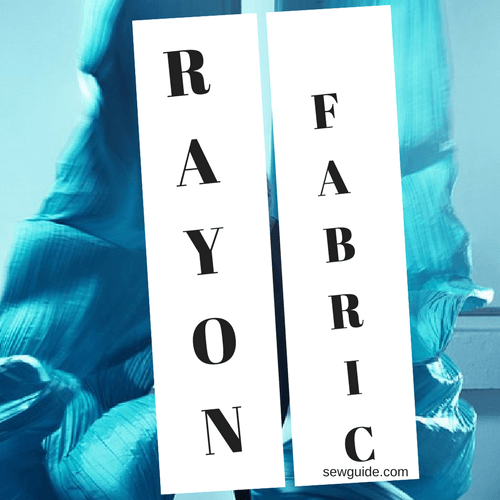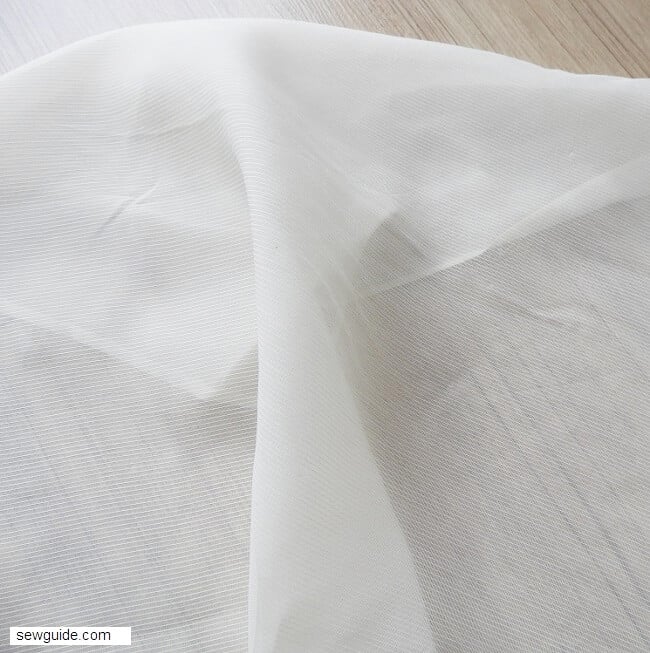
As a dressmaking material everyone loves, rayon is quite popular in fashion. We all have a top or dress in rayon which is very drapey, soft, and nice to look at. But do you know what rayon is and How it differs from all the other textiles you get in a textile showroom? Read on to find out more.
Rayon -definition
- Rayon -definition
- Rayon as a man made fabric
- Different types of Rayon
- Cupro Rayon
- Lyocell
- Bamboo fabric
- Modal
- Rayon challis
- Rayon blends
- What is Rayon made out of ?
- What are the qualities of Rayon fabric as a clothing material?
- Why is Rayon also called Articial silk?
- Name the first commercial version of Rayon fiber
- How is Rayon better than Cotton?
Rayon is a soft fabric made from regenerated cellulose fibers of wood or cotton. Other names of this fabric are Viscose, Art Silk, Tencel, Cupro, and Modal. Rayon is the generic name for these fabrics.
Rayon as a man made fabric
You get a little confused at classifying rayon because it is neither a fully natural fabric like cotton nor a fully synthetic one like Nylon. It falls somewhere in between. You can call it a Man-made fabric.
Rayon is one of the oldest manufactured fibers made from natural resources. By the 1920s, this fabric was fully acquired by Dupont company, and people fell in love with this silk-look-like versatile and inexpensive fabric.

Different types of Rayon
Rayon is available in knit as well as woven. Tencel, (Lyocell) Cupro, and Polynosic Rayon are different kinds of Rayon fabrics.
Viscose Rayon
The different Viscose Fabrics available for dressmaking are Viscose Georgette, Viscose Chiffon, Viscose Crepe, Viscose Gauze, Viscose Habotai, Viscose – Bemberg, Viscose Linen blend, Viscose Velvet, Viscose satin, Viscose Mesh, Viscose Taffeta, Viscose Twill.
Cupro Rayon
This is a strong variety of Rayon with a slight sheen ; It is slinky and looks like silk. Bemberg is a trade name of this variety in the US which is popular as a lining material. The fabric with the real name cuprammonium is made through a process that uses copper and ammonium.
Lyocell
This is an eco-friendly machine washable rayon that goes under the trade name Tencel®. It is a fabric known for its hypoallergenic quality, softness, drape, resistance to the growth of bacteria which create odors ( It absorbs excess sweat and quickly releases it into the atmosphere without leaving smell), and, most important of all, its reputation as a sustainable fabric which is friendly to the environment, unlike other rayon fabrics.
Bamboo fabric
Bamboo rayon is made from cellulose derived from bamboo wood pulp. Know more about bamboo fabric here
Modal
This is a very soft variety of rayon – in fact, it is considered one of the softest fabrics. But at the same time, it is stronger than other rayon fabrics and more resistant to shrinkage. One pet peeve with rayon fabrics is that it damages in the machine wash -but with modal rayon, this problem is solved – the fibers have great wet strength. It will not be stretched out of shape in the tumble wash like other rayon garments.
Read more on Modal fabric here.
Rayon challis
This is perhaps the most used fabric in dressmaking. It is soft and very drapey.
Rayon crepe has a subtle texture which is very appealing. Woven rayon is preferred in dressmaking to Rayon knits.
Rayon blends
Doubleknit Rayon Blend is a very comfortable strong rayon knit fabric that is also easy to maintain. Rayon-Lycra blend fabrics are also very much favored in dressmaking. You can make unstructured clothes with these fabrics.
What is Rayon made out of ?
Rayon fibers are derived from cellulose extracted from wood pulp from Bamboo, sugarcane, beech trees, pine trees, etc, but rayon is not considered a natural fiber nor a synthetic fiber; it is made from regenerated cellulosic fibers. Cellulose undergoes many chemical processes to become what you know as rayon.
The cellulose is treated chemically at first and made into a liquid which is then made into cellulose filaments. Processes like the Viscose process, cellulose acetate process, etc, are used to make the cellulose. All things utterly beyond my comprehension, but the resultant fabric is fantastic and makes beautiful garments, this I know.
In 1920, a patent was given to Dupont Chemicals for a process of creating this manufactured fiber which was inexpensive but at the same time had a lustrous sheen. This type of fabric was named rayon, referring to the rays of the sun. From that time to now, the quality of rayon has improved by leaps and bounds, and the fabric is now almost deserving of its name which means ‘reflecting the sun’s rays’. It is said to be the first major commercial synthetic fiber.
There are three main methods of making rayon fabric – one is the initial method of the cuprammonium process. Then the one of making viscose rayon. And finally, the method of making acetate rayon.
You can read more on acetate fabric here.
Nowadays, many fashion designers prefer to make their signature clothes in rayon.
What are the qualities of Rayon fabric as a clothing material?
First, let me start with the bad
- Rayon fades progressively.
- It shrinks progressively.
- The fibers are weaker than cotton or silk, especially when wet.
- It wrinkles fast.
- You cannot use very hot temperatures on it.
- It changes shape /dimension with abrasion and washings.
- Colour of the fabric may bleed or run.
- It is susceptible to mildew.
- You may need to dry clean it to maintain its original look. Washing with over-abrasion may even cause it to lose its softness and draping quality.
- It does not breathe as much as other natural fabrics, and you may sweat a lot in it.
- It is slightly inflammable ( more so than natural fibers).
- It does not have natural elasticity and do not stretch to accommodate wearing ease.
- It develops rough textures after some use.
Look at the seams of a new rayon dress I bought. Agreed it is not top-quality rayon clothing – still, I bought it with love. I cannot imagine this one lasting many wash cycles. The seams are already fraying.

Do not be fazed by all these demerits. Ryon has its share of merits as well. There are top-quality varieties of rayon that do not have any faults and are dream fabrics for a sewist.
- Viscose Rayon is soft, absorbent and non-static
- It is lustrous and has a beautiful sheen, and looks vibrant.
- You can dye it very easily.
- You can bleach it as well (with care) or provide a number of finishes.
- It is a relatively inexpensive fabric.
- It drapes beautifully and is one of the most preferred wedding dress materials
- It is heavier than silk.
- It blends well with other fibers.When Rayon is blended with other fibers like polyester, wool, linen, Georgette it takes on many of the qualities of those fibers.
- Rayon can be made stretchy by blending it with Lycra, and this blend is lightweight.
- It is breathable.
- Some rayon can be as fine as any fabric and see-through.

So many things to love. Some of my most loved dresses and night dresses are made of Rayon. They are very soft to touch and comfortable to wear.
Buy good quality Rayon without compromising on cost and you will not regret buying Rayon (Viscose as it is called in some places) – the beautiful dresses you can make with it will make it worth the price.
Related posts : Different types of fabrics – names
Why is Rayon also called Articial silk?
The fact that Rayon is called Artificial Silk (faux silk for some) tells you a lot about the feel of Rayon. It is a fabric made with a semi-synthetic fiber made from cellulose that is very similar to silk – its drape, softness all similar to silk. After all, it was manufactured during the 1880s, as a cheap alternative to silk.
Name the first commercial version of Rayon fiber
Nitro rayon or Chardonnet rayon. This is also the first man-made fibre; it was made from cotton waste.
How is Rayon better than Cotton?
Rayon is a more drapey fabric than cotton. Most varieties of cotton are thicker than rayon fabric and may not drape nicely on the body as rayon does. Rayon also has a fine lustre which may not be there in a lot of cotton fabrics. But there are more disavantages to rayon when compared to a natural fabric like cotton than advantages. Rayon is not as sturdy or durable as cotton, nor is it as skin friendly. After all it is a man made fabric.

I couldn’t find satin in your list. If I am wrong I do apologise.
Thank you for the info it will be helpful when I start making some summer dresses. I live in south Florida, summer year around.
Hi!
I am about to start my own short sleeve shirts brand. My idea is to produce the shirts in Indonesia (my partner leaves there) and we were thinking of making the shirts out of Rayon. However, we found out that there are many types of rayon and we are afraid we buy that extra thin one. Do you know how i avoid these problem? What type of rayon should I look for?
Thanks in advance,
Regards